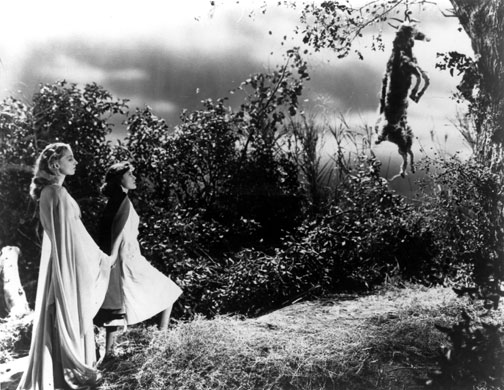Two years ago I did a series on Halloween movies of the science-y kind (see "Dead Of Night": The Horror Movie That Inspired Hoyle's Steady State Model and others). I was following a long tradition here at Science 2.0 , from early entries like Everything I Need To Know About Science I Learned From Watching "The Lost Skeleton Of Cadavra" to Garth Sundem's Halloween Movies Vs Bad Poetry.
So I know science-based Halloween movies aren't going to get their mindshare here but I am going to write about them just the same. I can only make fun of anti-sience progressives who insist fracking will cause Earth to deflate so many times before I need a break. So let's talk about I Walked With A Zombie, which strays from the physics and aliens and history I discussed in other movies and delves into psychology and mysticism.
In the opening sentence I said that when priorities at a movie company change, artists can get a lot more creative under those new restrictions, and maybe even make something a little better. RKO was a small Hollywood Studio but they felt like they had a big star in Orson Welles. They believed in his art. Unfortunately his art made them bankrupt. A sign during the early days of World War II at Paramount read "In case of an air raid, go directly to RKO. They haven't had a hit in years!" (3)
So imagine an art studio that gets a new boss who wants horror movies on a budget and he says something like 'Vampires and werewolves have been overdone, make something about cats!' to his new producer, Val Lewton. It should have been a train wreck but suddenly "Cat People", which only cost $130,000, grossed $1 million in its initial run and $4 million over time, staying in theaters longer than Welles' "Citizen Kane", which the somewhat ridiculous American Film Institute claimed was the greatest film of all time during the entire 20th century (4).
Now imagine the studio wants a follow-up and the studio head is still picking movie titles based on market research - and so "I Walked With A Zombie" is going on the poster. Who sits in the production meeting and introduces an idea like 'You know what would make a great zombie movie? Jane Eyre'.
Charlotte Brontë's 1847 indictment of Victorian culture wouldn't ordinarily lend itself to a zombie movie but Lewton was seeing bigger picture. It had references to Jamaica and crazy people and the supernatural. "I Walked With A Zombie" uses an unsympathetic married man and a nurse who gradually falls in love with him.
But what makes the movie is the cinematography of Nick Musuraca and the moody direction of Jacques Tourneur. Lacking a special effects budget, they had to suggest horror. They did meticulous amounts of research on Voodoo culture and then introduce the ambiguity of science versus supernatural forces - is the wife really cursed by Voodoo, is it a physical malady caused by a tropical disease, or is she crazy?

The trio counted on the psychology of movie-goers too. What people cannot see is often scarier than what they can. It's why "The Blair Witch Project" was a runaway success six decades later.
But don't discount the story - the counterpoise is terrific and alternating beauty and danger visually adds to it. “It’s easy enough to read the thoughts of a newcomer. Everything seems beautiful because you don’t understand. Those flying fish, they’re not leaping for joy, they’re jumping in terror. Bigger fish want to eat them. That luminous water, it takes its gleam from millions of tiny dead bodies. The glitter of putrescence. There is no beauty here, only death and decay.”
Even the credits are having some fun with World War II America: "The characters and events depicted in this photoplay are fictional. Any similarity to any persons, living, dead, OR POSSESSED, is entirely coincidental."
The New York Times panned it but they had endorsed Hitler and eugenics a few years earlier so they had clearly lost their minds for a time. RKO was certainly happy with the film, and the vision of Lewton, especially after losing so much money on the intellectual golden boy Welles, who found additional success on his own later, notably being in commercials for cheap wine and as the voice of Optimus Prime in "Transformers: The Movie."
NOTES:
(1) For other under-appreciated articles that deviate from mainstream science writing, see Dr. Michael White's 60 Years Of End-Of-The-World Science Fiction.
(2) That metaphor plays on multiple levels, actually, which makes it pretty awesome
(3) From the second autobiography by actor David Niven, Bring on the Empty Horses.
(4) It should be The Godfather. Everyone knows that.





Comments